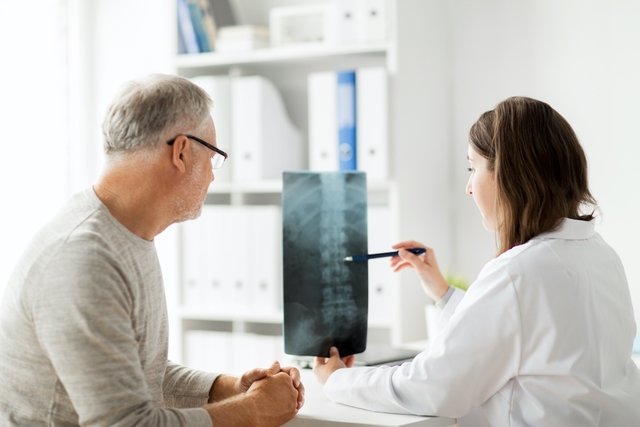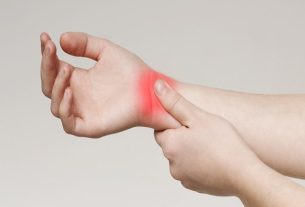Bone tuberculosis is a type of extrapulmonary tuberculosis in which the bacteria Mycobacterium tuberculosis it spreads in the bloodstream and settles in the bones and joints, mainly in the spine, hips and knees.
The main symptoms of bone tuberculosis include pain in the area infected by the bacteria, stiffness in the joints and difficulty in movement. See all the symptoms of tuberculosis.
Bone tuberculosis is more common in children and the elderly, and it is important that the infection is identified as soon as the first symptoms appear, as this means that treatment can be started straight away, which is done with antibiotics, and prevent possible complications.

Symptoms of bone tuberculosis
The main symptoms of tuberculosis in the bones are:
- Pain in the spine, hip or knee joint, which progressively worsens;
- Difficulty in movement, when bending the leg or walking with a limp;
- Swelling in the knee, when it is affected;
- Decrease in muscle mass in the affected leg;
- There may be a low fever.
It is important to consult an orthopedist, infectious disease specialist or general practitioner whenever symptoms of tuberculosis appear in the bones, so that they can identify and initiate treatment, in order to avoid complications.
How to confirm the diagnosis
The diagnosis of bone tuberculosis is made by an orthopedist or infectious disease specialist through evaluation of symptoms, history of tuberculosis and treatment, physical examination and test results.
Make an appointment with the orthopedist in the region closest to you:
Taking care of your health has never been easier!
Thus, the doctor may request a sputum examination to test for the tuberculosis bacillus, to identify infection by the bacteria. Mycobacterium tuberculosis.
In addition, an X-ray, MRI or ultrasound examination may be requested, as well as a biopsy of the synovial fluid or affected bone.
What causes bone tuberculosis
Bone tuberculosis is caused by the bacteria Mycobacterium tuberculosisalso known as Koch’s bacillus, and the infection occurs when a person breathes in airborne particles containing the bacteria that are released when a person with pulmonary tuberculosis speaks, sneezes or coughs.
Initially, the bacteria enters through the respiratory tract but soon reaches the blood and spreads throughout the body, reaching the bones, mainly the spine, hips and knees, leading to the appearance of symptoms.
In some cases, bone tuberculosis can also be a consequence of the reactivation of pulmonary tuberculosis that was not treated correctly, so the bacteria can more easily reach the bones, especially the spine, this situation being known as Pott’s disease. Learn more about Pott’s disease.
How the treatment is carried out
The treatment of bone tuberculosis must be carried out according to the doctor’s instructions, with the use of a combination of antibiotics being recommended to promote the elimination of the bacteria, and it is important to use these medications even if the symptoms have disappeared. Understand how tuberculosis is treated.
Read too: 4×1 medicine for tuberculosis: what it is and how it works
In addition, physiotherapy may also be recommended to reduce the pain and discomfort generated, increasing free movement of the joints and strengthening the muscles.
Physiotherapy can be performed 2 to 5 times a week and electrotherapeutic resources, joint mobilization, stretching and strengthening exercises can be used to recover muscle mass.
Possible complications
In cases where bone tuberculosis is not identified and treated correctly, complications such as bone deformity, spinal instability, shortening of the leg are possible, which can lead to scoliosis and even paralysis.
Bibliography
- TYAGI, R.; et al. Odd presentations of skeletal tuberculosis: A case series. Indian J Tuberc. 70. 1; 124-128, 2023
- JAUHARY, T.; HAYATI, F. Unusual sites of tuberculosis mimicking skeletal metastases: A case report. Radiol Case Rep. 17. 6; 2898, 2022
- PATTAMAPASPONG, N.; et al. Imaging of musculoskeletal tuberculosis. Br J Radiol. 97. 1153; 1-12, 2024
- KHANNA, K.; SABHARWAL, S. Spinal tuberculosis: a comprehensive review for the modern spine surgeon. Spine J. 19. 11; 1858-1870, 2019
- ÇAY, Ü.; et al. Skeletal Tuberculosis in Pediatric Population for 15 Years; Twenty Cases from Southern Turkey. Niger J Clin Pract. 26. 11; 1602-1609, 2023
- VISWANATHAN, V. K.; SUBRAMANIAN, S. IN: STATPEARLS (INTERNET). TREASURE ISLAND (FL): STATPEARLS PUBLISHING. Pott Disease. 2023. Available at: <https://www.ncbi.nlm.nih.gov/books/NBK538331/>. Accessed on April 12, 2024

Sign up for our newsletter and stay up to date with exclusive news
that can transform your routine!
Warning: Undefined array key "title" in /home/storelat/public_html/wp-content/plugins/link-whisper-premium/templates/frontend/related-posts.php on line 12
Warning: Undefined array key "title_tag" in /home/storelat/public_html/wp-content/plugins/link-whisper-premium/templates/frontend/related-posts.php on line 13



